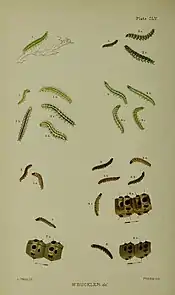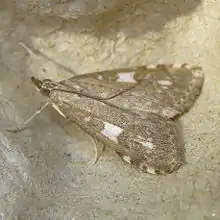Udea olivalis
Udea olivalis is a species of moth of the family Crambidae. It was first described by Michael Denis and Ignaz Schiffermüller in 1775 and is found in Europe.
.jpg.webp)

| Udea olivalis | |
|---|---|
 | |
| Scientific classification | |
| Domain: | Eukaryota |
| Kingdom: | Animalia |
| Phylum: | Arthropoda |
| Class: | Insecta |
| Order: | Lepidoptera |
| Family: | Crambidae |
| Genus: | Udea |
| Species: | U. olivalis |
| Binomial name | |
| Udea olivalis (Denis & Schiffermüller, 1775) | |
| Synonyms | |
| |
The wingspan is 24–28 mm. The forewings are greyish ochreous or brownish, densely sprinkled with dark fuscous lines hardly darker, indistinct, second serrate, often posteriorly whitish -edged, preceded in middle by a white spot, curved, with abrupt deep sinuation inwards below middle; large orbicular and reniform discal spot darker, separated by a subquadrate white spot; posterior half of costa whitish, dotted with dark fuscous. Hindwings white, dorsal half light grey; two dark grey discal dots; a fuscous terminal fascia. The larva is light green; dorsal line dark green; spots large, black; head and plate of 2 black-freckled[1]
The moth flies from May to August depending on the location.
The larvae feed on various herbaceous plants, such as Hedera helix, Lychnis, Urtica, Symphytum officinale and Lamiaceae.
References
- Meyrick, E., 1895 A Handbook of British Lepidoptera MacMillan, London pdf
 This article incorporates text from this source, which is in the public domain. Keys and description
This article incorporates text from this source, which is in the public domain. Keys and description
External links
- Waarneming.nl (in Dutch) Archived 2012-07-29 at the Wayback Machine
- Lepidoptera of Belgium
- Udea olivalis at UKMoths